平成31年04月13日 土曜日号
“版画 平成4年”
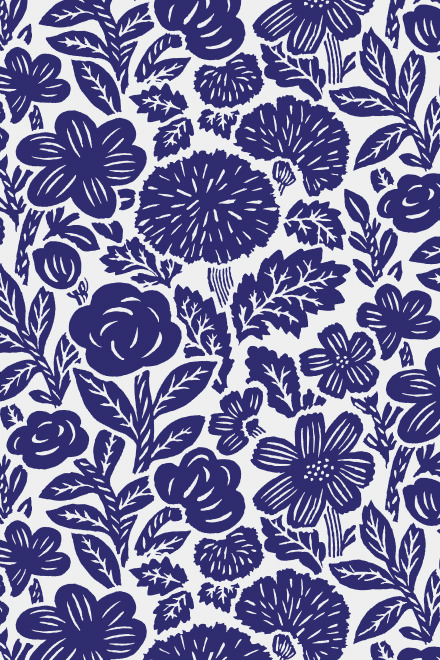
木版に彫刻刀で花や葉をほっていく。
間には線を入れて表情を出していく。
版画は筆とは違った
シャープな線が持ち味だ。
この絵もなんとなく版画の様に
民芸調の面白さが出た。
(脇阪克二)
Woodblock print(1994, by Katsuji Wakisaka)
With a carving knife in hand,
chisel flowers and leaves out of a piece of wood.
Woodblock print features sharp image lines.
This textile design is somehow similar to woodblock print,
with the appearance of handmade fork craft style.
| English translation by LI XIAO XIAO |
Gravure(1994, par Katsuji Wakisaka)
Je grave sur bois des fleurs et des feuilles avec un ciseau à bois.
Entre ces motifs, j’ai inséré des fils pour en augmenter la physionomie.
La gravure est différente de l’estampe.
Les traits incisifs sont l’archétype du Soi.
À l’image de la gravure, je trouve que ce dessin retranscrit plutôt bien
l’originalité de l’art populaire.
| Traduction française par Jean-Baptiste Fauvel |
版畫(1994, 脇阪 克二)
在木頭上用雕刻刀刻繪出花和葉,
再于其間加入綫條,勾繪出生動的神韻。
版畫與毛筆畫不同,
綫條風格剛硬,畫面中有「刀的味道」。
我畫的這張圖案,
綫條如版畫,輪廓鮮明,
散發民藝風的和之趣味。
| 中譯 : 李 瀟瀟 |
→こちらのテキスタイルデザイン商品
(Textile products with this pattern)
平成31年04月10日 水曜日号
“きざし 平成12年”
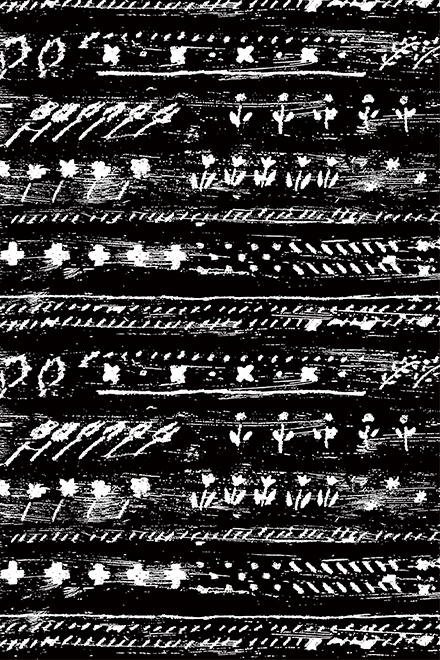
まだ冬の寒い日、
野の山も凍りついている。
こんな時にふきのとうは芽を出す。
ふきのとうだけではなく
よく見ると凍てついた大地の
そこかしこに芽を出そうとする
植物が動き出している。
冬来たりなば春遠からじというように
春のきざしが顔をのぞかせはじめている。
(脇阪克二)
Signs of spring(2000, by Katsuji Wakisaka)
A cold day of winter
hills and fields are still frozen.
On this season Fukinotou (Petasites japonicus) put out its bud.
Not only Fukinotou -
if you look closely, many plants are ready to come up
from the freezing ground everywhere.
“If Winter comes, can Spring be far behind?”
Sings of spring are here and there.
| English translation by Futaba Komori |
Signes et présages(2000, par Katsuji Wakisaka)
Dans les jours encore froid de l’hiver,
les champs des montagnes sont encore gelés.
Le pétasite du Japon commence à germer en cette période
Pas seulement le pétasite, on peut voir d’autres plantes
qui essaient de sortir de la terre froide et solidifiée.
Comme le veut l’adage « Si vient l'hiver, le printemps peut-il être loin ? »,
des signes de l’arrivée du printemps commencent à pointer.
| Traduction française par Jean-Baptiste Fauvel |
春之兆(2000, 脇阪 克二)
時為冬末,
野外山中天寒地坼,
款冬花莖卻冒出嫩芽。
細看會發現發芽的不止款冬,
寒霜凛凛中,
各種植物都在萌發。
“冬來春不遠”,
處處充滿春天來臨的徵兆。
| 中譯 : 李 瀟瀟 |
平成31年04月06日 土曜日号
“菊花文 平成30年”
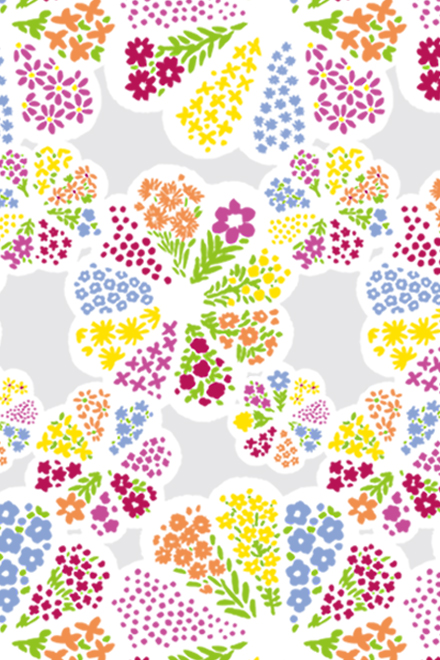

ししゅうで表現された色とりどりの
小花が形づくる 菊花文の着物から
アイデアをいただいた
今風に見えるが 昔のもので
渋い色の着物だった
こういうものを見ていると
古い着物の中に 模様として
魅力的なものが 埋もれている
これからも 日本人の心をとらえる
模様を発掘していきたい
(脇阪 克二)
"Chrysanthemum pattern"(2018, by Katsuji Wakisaka)
Kimono embroidered with small chrysanthemums inspired me.
It looks like a popular mordern style but,
Surprisingly, it really is a traditional antique design.
We can find numerous fascinating patterns in old kimono.
I will continue striving for discovering the good old designs,
which touching Japanese people's hearts.
| English translation by LI XIAOXIAO |
"Motif de chrysanthème "(2018, par Katsuji Wakisaka)
Les kimonos brodés au motif de petit chrysanthème m’a toujours inspiré.
Cela ressemble étrangement à un motif moderne populaire mais
il s’agit en réalité d’un design purement traditionnel.
Il existe de nombreux motifs fascinants dans les anciens kimonos.
Je me fais une mission personnelle de continuer à les dénicher,
dans le but de toucher le coeur des Japonais.
| Traduction française par Jean-Baptiste Fauvel Matsumoto |
"菊花紋"(2018, 胁阪 克二)
這幅印花設計靈感來源於:
用刺綉表現五顔六色菊花紋的和服。
乍看氛圍十分現代,實為古樸的和服紋樣。
在舊時傳統服飾中,掩藏著許多諸如此迷人的模樣,
它們是觸動日本人的紋樣,
也是我想要持續發掘的寶藏。
| 中译 : 李 瀟瀟 |
→こちらのテキスタイルデザイン商品
(Textile products with this pattern)
平成31年03月20日 水曜日号
“吹きよせ 平成25年”
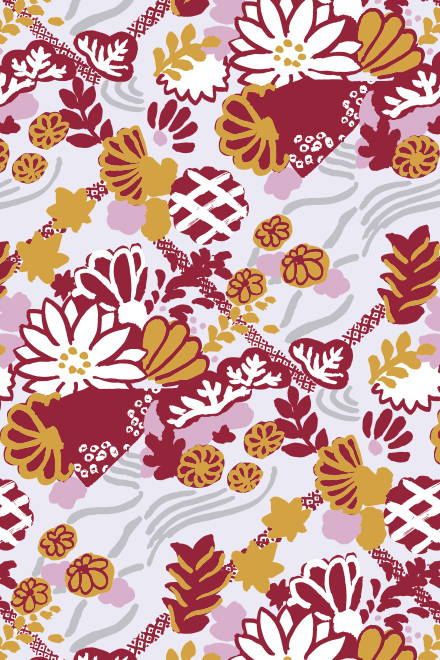
風が木の葉をちらし
花や実も吹きよせられて
地面に模様をつくる
風が吹くたびに
カサカサという音とともに
模様も変化していく
(脇阪克二)
Nature-drift(2014, by Katsuji Wakisaka)
Wind blowing leaves of trees
flowers and nuts are also drifted
and drawing patterns on the ground.
As they all rustle in the breeze,
the patterns are shifting on the ground.
| English translation by Futaba Komori |
Porté par le vent(2014, par Katsuji Wakisaka)
Le vent fait tomber les feuilles des arbres
tout comme ses fleurs et ses fruits,
créant par terre des motifs naturels.
A chaque fois que le vent souffle,
d’un bruissement léger,
ces mêmes motifs changent.
| Traduction française par Jean-Baptiste Fauvel |
隨風(2014, 脇阪 克二)
風吹散樹葉,
吹落繁花,
吹掉果實。
在地面上排列出好看的模樣。
風每經過一次,
地上的圖案就沙沙沙地,
變換紋樣。、
| 中譯 : 李 瀟瀟 |
→こちらのテキスタイルデザイン商品
(Textile products with this pattern)
平成31年03月16日 土曜日号
“霞 平成25年”
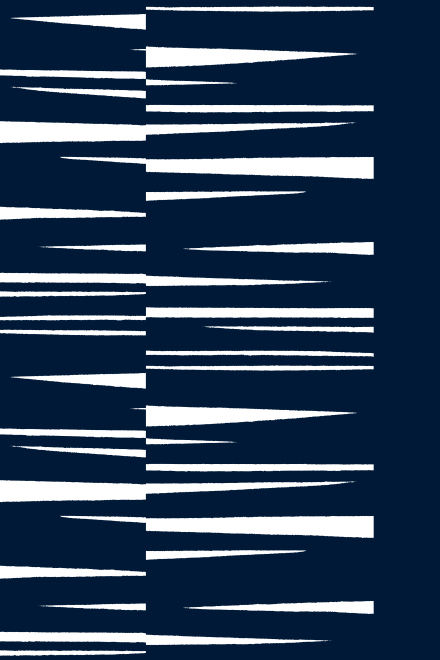
雲というにはあまりにもうすく
横に横にたなびいていく霞。
山々をかすめ家々をぼかし
どこまでも水平にひろがっていく。
霞に包みこまれた風景は
静かで日本ならではの
やさしい状景を見せてくれる。
(脇阪克二)
Haze (2014, by Katsuji Wakisaka)
A haze trailing the air
too faint to be called a cloud.
Mountains are fading, houses are blurred,
and it spreads anywhere horizontally.
The scenery covered by haze
let us see the softness and tranquility of Japan.
| English translation by Futaba Komori |
La brume (2014, par Katsuji Wakisaka)
Plus clair et léger que les nuages,
la brume flotte de côté.
Des montagnes embrumées,
des maison sous la brume,
elle s’étend jusqu’à l’infini, horizontale.
Silencieuse, elle nous fait découvrir
sous un autre visage les beaux paysages japonais.
| Traduction française par Jean-Baptiste Fauvel |
霞 (2014, 脇阪 克二)
霞比雲輕柔,
無止儘地橫向蔓延。
群山朦朧,山中人家隱現。
這被霞籠罩的風景,
靜謐雅致,
霞景之美,和之美。
| 中譯 : 李 瀟瀟 |
→こちらのテキスタイルデザイン商品
(Textile products with this pattern)
平成31年03月05日 火曜日号
“辻が花 平成30年”
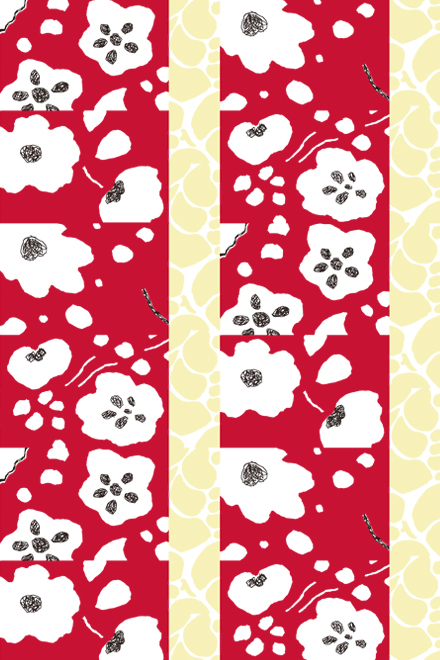

室町末期から 江戸初期の
短期間 降盛をきわめ
姿を消していった辻が花。
大らかで のびやか
味わいの深さは
他の染め物にはない
独特の世界がある。
新しい時代に向かって
人々が躍動していた
桃山の息吹を感じる。
(脇阪 克二)
"Tsuji-ga-hana Pattern"(2018, by Katsuji Wakisaka)
Tsujigahara is a Japanese highly valued fabric dyeing technique.
It lasted from Muromachi period to Edo period for about 300 to 400 years, but quickly became forgotten.
Tsujigahana style pattern of refined sentiment,
bringing otherworldly unique elegance,
harkens back to Japan'sgolden age, the Momoyama era.
| English translation by LI XIAOXIAO |
"Motif Tsujigahara"(2018, par Katsuji Wakisaka)
De la fin de l’ère Muromachi jusqu’au début de l’’ère d’Edo,
la technique de teinture de fabrique appelée Tsujigahara
fut à la mode pendant une courte période avant de tomber dans l’oubli.
Elle possède son propre monde, profond, généreux et aisé à la fois.
En route vers un nouvel âge, elle laisse une trace indélébile des japonais
plein de vie de l’ère Momoyama.
| Traduction française par Jean-Baptiste Fauvel Matsumoto |
"辻花紋樣"(2018, 胁阪 克二)
辻之花,是日本室町時代末期至江戶初期,
曇花一現的和服紋樣。
纖細而優雅,
有別於其他一切染織花色,
如仙山瓊閣,
傳達著人們迎向新時代的雀躍。
辻之花,瑤草琪花,
一眼驚鴻,如夢似幻。
| 中译 : 李 瀟瀟 |
→こちらのテキスタイルデザイン商品
(Textile products with this pattern)
平成31年03月02日 土曜日号
“おひなさま 平成23年”

あかりをつけましょうボンボリに、
お花をあげましょう桃の花…。
ひなまつりのこの歌はとても愛らしい。
女の子が生まれた喜びが感じられる。
その子が心身共に健やかに成長していってほしい
という願いを込めておひなさまを飾る。
(脇阪克二)
Ohina dolls (2011, Katsuji Wakisaka)
The song 《Happy Dolls Fextival》sings,
"Let's light the lanterns on the tiered stand/
Let's put peach blossoms on the tiered stand/..."
People in the celebrative mood for a newborn girl,
Praying for her healthy growth and decorate hina-dolls.
| English translation by LI XIAO XIAO |
Le festival des poupées (2011, par Katsuji Wakisaka)
Allumons la lumière des lanternes en papiers,
Ornons le tout de fleurs de pêches…
Cette chanson du festival des poupées est magnifique.
On y ressent la joie de la naissance d’une petite fille.
Nous habillons les poupées de nos souhaits
de voir grandir pleinement et en bonne santé cet enfant.
| Traduction française par Jean-Baptiste Fauvel Matsumoto |
女兒節人偶(2011, 脇阪 克二)
「點上燈吧朦朧的紅燈籠
獻上花吧粉紅的小桃花……」
這是日本女兒節的童謠
傳達出女孩誕生的歡慶氛圍
三月三日這天
有女兒的人家會在家裝飾女兒節人偶
祈願小女孩身心健康地成長
| 中譯 : 李 瀟瀟 |
→こちらのテキスタイルデザイン商品
(Textile products with this pattern)
平成31年01月30日 水曜日号
“おもかげ 平成22年”
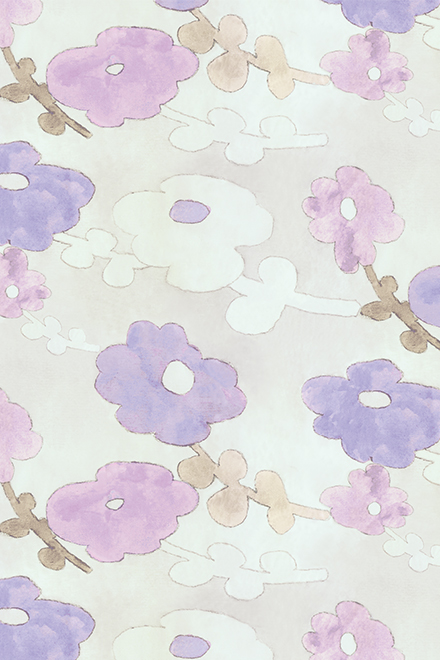
ぼんやりと浮かんでくるが
はっきりとは思い出せない。
遠い遠い昔のことだった様な感じがする。
夢のようでもあるようだけど
でも本当にあったことだ
追えば追う程つかめないあの日。
(脇阪克二)
Obsqure image (2010, Katsuji Wakisaka)
An obscure image comes in my mind
but I can not remember what it is.
Is it from a distant memory?
It is also like a dream
but I know, it actually happened.
As I run after the vague memory
"that day" runs far away from my mind.
| English translation by Futaba Komori |
Souvenir obscur (2010, par Katsuji Wakisaka)
Cela me revient à l’esprit mais
je ne me souviens pas correctement,
comme un lointain souvenir oublié.
On se croirait dans un rêve mais
cela s’est vraiment passé.
Plus je m’en rapproche, plus je m’en éloigne.
| Traduction française par Jean-Baptiste Fauvel Matsumoto |
面影(2010, 脇阪 克二)
回憶迷離恍惚,
細節影影綽綽。
那是隱約的遙遠的過去。
越是追憶,越看不真切,
一切恍然如夢,
卻又真實發生過。
| 中譯 : 李 瀟瀟 |
→こちらのテキスタイルデザイン商品
(Textile products with this pattern)
平成31年01月28日 月曜日号
“槍袋文様 平成30年”
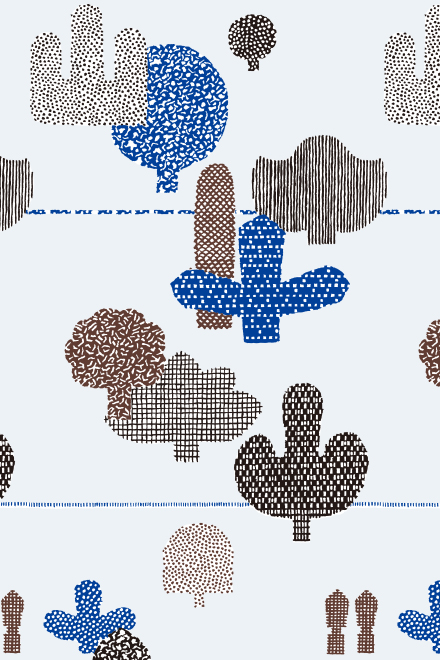

このサボテンのような不思議な
形はなんだろうと思われるかも
しれません
これは 狂言の衣裳に
描かれていた 槍を入れる袋
昔のものというより
どこか宇宙的な感じもする
魅力的な文様ですね
(脇阪 克二)
"Spear bag pattern"(2018, by Katsuji Wakisaka)
Look at these cactus!
But, the truth is that they are spear bag pattern
Printed on the stage costumesfor kyogen (a Noh farce).
Pattern on the Japanese traditional clothing,
Comes from the past,
Breathes an futurist charm.
| English translation by LI XIAOXIAO |
"Étui à lances"(2018, par Katsuji Wakisaka)
Que peut bien être cet étrange amas
en forme de cactus, me diriez-vous?
Il s’agit d’un étui souvent dessiné sur
les costumes de théâtre Kyogen.
Plutôt qu’ancien, il donne l’impression
de venir d’un autre monde…
Quel beau design, ne trouvez-vous pas?
| Traduction française par Jean-Baptiste Fauvel Matsumoto |
"槍袋紋樣"(2018, 胁阪 克二)
你看這些奇妙花紋,
好似仙人掌,不可思議。
這其實是日本傳統戲劇狂言表演中,
畫在舞臺服裝上裝槍用的口袋形狀。
傳統服裝紋樣的魅力之一在於,
偶有這般超越時空的宇宙般抽象。
| 中译 : 李 瀟瀟 |
→こちらのテキスタイルデザイン商品
(Textile products with this pattern)
平成31年01月26日 土曜日号
“やたら編み 平成12年”
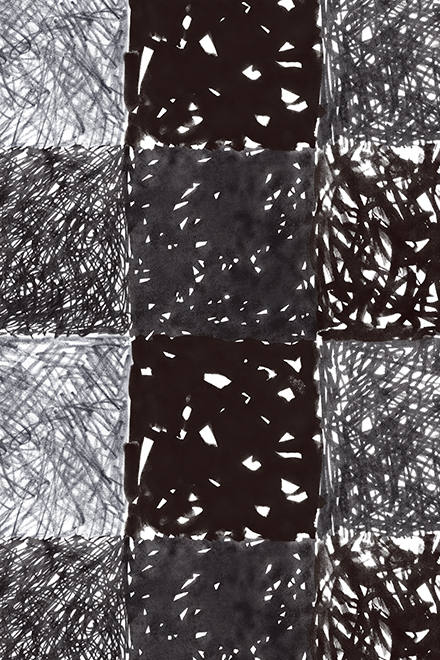
無茶苦茶に編んだような編み方がある。
秩序がないように見えるけれど、
上手く間を取りながら編んでいるのだろう。
独特の美しさがある。
グチャグチャ ガシャガシャと
無秩序に描いたけれど、
四角におさめてバランスをとった。
(脇阪克二)
Random knitting(2000, Katsuji Wakisaka)
There is a method of knitting that looks uneven.
While there is no rule for the method,
it must be knitted very skillfully -
I could see its beautiful uniqueness.
After drawing lines randomly without any rules,
I nicely fixed them in squares.
| English translation by Futaba Komori |
Amas de mailles (2000, par Katsuji Wakisaka)
Il existe des techniques de tressage incompréhensibles.
On dirait qu’il n’y pas de motifs mais tout est bien pensé.
Quelle beauté unique.
J’ai dessiné un design aléatoirement sans motifs particuliers,
que j’ai mis dans une forme carré de façon équilibrée.
| Traduction française par Jean-Baptiste Fauvel Matsumoto |
自由編(2000, 脇阪 克二)
竹編的技法中,有一種自由隨性的編作方式叫做“自由編”,
所用的竹篾寬窄長短不一,看似毫無規則地自由穿插,
只要把握好間隙大小,編作出一種無秩序的美感。
我把自由編放進四方形的格子裏排開,
創作出的紋樣和諧美好。
| 中譯 : 李 瀟瀟 |
→こちらのテキスタイルデザイン商品
(Textile products with this pattern)
平成31年01月19日 土曜日号
“あんこ玉 平成21年”
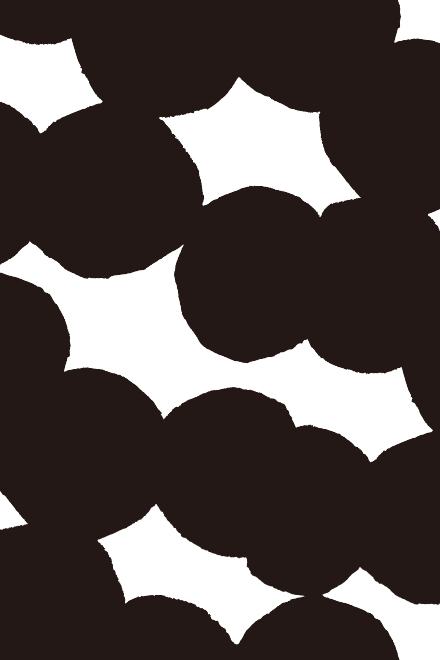
小豆のあんを手の中で転がして丸めたあんこ玉。
丸い形なのだけれど、どことなくへこんだり、
ふくらんだりしているところが、
親しみが湧くしおいしそうだ。
これを包みこんでおまんじゅうを作る。
(脇阪克二)
A bean-paste ball (2009, by Katsuji Wakisaka)
A bean-paste ball, made by rolling a sweet bean-paste with hand.
How its shape is not perfectly round and deformed in some way,
makes the bean-paste ball even more favorable and delicious-looking.
I will wrap them in the flour skin and make a manju (steamed bean-jam bun).
| English translation by Futaba Komori |
Boule de pâte de haricots rouges (2009, par Katsuji Wakisaka)
Boule de pâte de haricots rouges faite à la main.
Même si de forme ronde, elle est enfoncée par endroit,
et un peu plus gonflée dans d’autres, ce qui la rend
artisanale et familiale. Qu’elle a l’air délicieuse.
Je la fourre au final pour en faire un manjū.
| Traduction française par Jean-Baptiste Fauvel Matsumoto |
豆沙丸(2009, 脇阪 克二)
紅豆沙搓成圓圓的餡料,
細看又不是完全光滑匀净的球體。
那些凹凸不平的細部,
反而讓人覺得親切。
把這些美味豆沙丸,
包成豆沙饅頭吧!
| 中譯 : 李 瀟瀟 |
平成31年01月16日 水曜日号
“北の国 昭和55年”
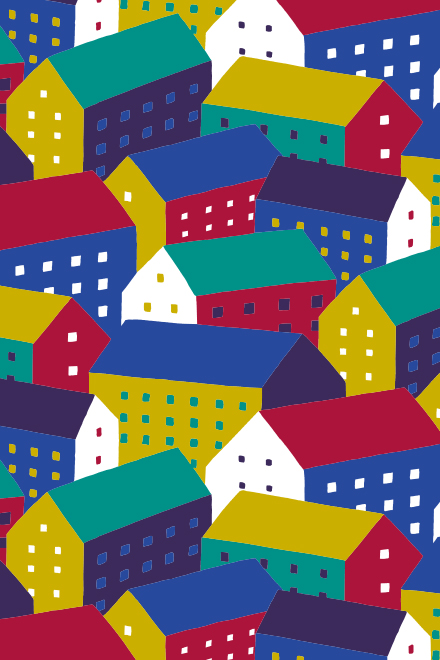
昔 僕はフィンランドに住んでいた。
退屈で淋しい国だった。
それがいやでニューヨークに移り住んだ。
はるかな時が過ぎ
日本に戻っていた僕は25年ぶりに
フィンランドへ行った。
そこはやはり静かで淋しい国だった。
でもその淋しさも含めて
フィンランドは僕の原点であり
仕事すること生きていくことを教えてくれた
思い出多い北の国だ。
(脇阪 克二)
A Northern Country (1980, by Katsuji Wakisaka)
Once I was living in Finland.
It was a boring, lonesome place.
So that I moved to New York, and came back to Japan.
A long time have passed by,
and I visited Finland for the first time in 25 years.
The country was still quiet and lonely.
But including its tranquility,
Finland is a memorable place for me.
That northern country is my starting point
which tought me how to do the work, and how to live my life.
| English translation by Futaba Komori |
Pays Nordique (1980, par Katsuji Wakisaka)
Autrefois, j’habitais en Finlande,
un pays ennuyant et désolé.
Ne m’y faisant pas, j’ai déménagé à New-York.
De longues années plus tard,
Je suis retournée en Finlande 25 ans après.
Bien entendu, le pays était toujours aussi calme et désolé.
Mais cette Finlande désolée fait partie de mes origines,
m’ayant enseigné l’importance du travail et de la vie.
Oh toi, Pays Nordique, rempli de souvenirs…
| Traduction française par Jean-Baptiste Fauvel Matsumoto |
北國(1980, 脇阪 克二)
我曾在芬蘭住過一段時間,
當時嫌那裏無聊又冷清,後來便移居紐約。
再後來我回到日本,
時隔25年有了重訪芬蘭的機會,
卻仍覺得那片土地僻靜寂寥。
但也是這北國的沉寂,
教會了我何爲工作,爲何生活,
那是我的原點,也是我無法取代的回憶。
| 中譯 : 李 瀟瀟 |
→こちらのテキスタイルデザイン商品
(Textile products with this pattern)
平成31年01月12日 土曜日号
“明かり窓 平成18年”
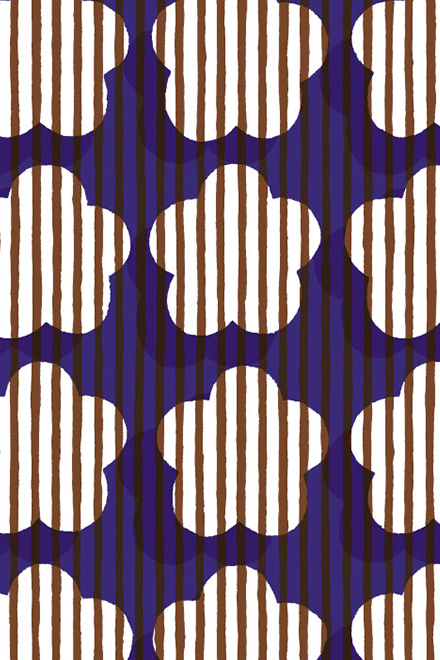
庭に面した部屋の壁につくられた明かり窓。
花の形に明けられた窓の障子をあけると
一幅の絵のような庭が見える。
障子をしめても窓の形と
障子をとおしたやわらかい光が
部屋を暖かく居心地のいいものにしてくれる。
(脇阪 克二)
"Daylight Window"(2006,by Katsuji Wakisaka)
A daylight window, on a wall of a room facing a garden.
If you open the flower-shapen shoji, a sash-window made of paper and wood,
the scene of a pictorial garden comes in your sight.
Even the time you close the window,
its lovely shape and the soft sunlight coming through the shoji
makes the room warm and comfortable.
| English translation by Futaba Komori |
"Lucarne"(2006, par Katsuji Wakisaka)
Lucarne construite dans la pièce face au jardin.
En ouvrant ses volets en forme de fleur,
le jardin nous apparait comme un tableau.
Même les volets fermés, sa forme si particulière
et la lumière douce qui la traverse la journée
en font un endroit chaleureux et paisible.
| Traduction française par Jean-Baptiste Fauvel Matsumoto |
"明窗"(2006, 胁阪 克二)
那廂房朝向庭院的墻,
開了一扇明亮的花形紙窗。
從房内往外望,明窗把庭院切成畫,
花形畫框,一窗一窗。
合上窗,從和紙透出輕柔的微光,
融融暖意,引人悠然神往。
| 中译 : 李 瀟瀟 |
→こちらのテキスタイルデザイン商品
(Textile products with this pattern)
平成31年01月09日 水曜日号
“数遊び 平成21年”
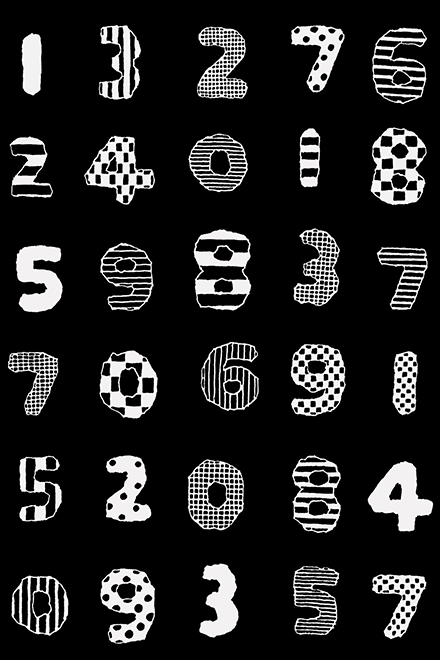
「SO-SU-U」のバリエーションのひとつ。
SO-SU-Uはどのように変化させても魅力的。
SO-SU-Uはどんな商品になっても魅力的。
アイテムを選ばず性別を選ばず年齢を選ばず人種を選ばない。
SO-SU-Uのバリエーションは
これからも広がっていくだろう。
(脇阪 克二)
"Playing with Numbers"(2009,by Katsuji Wakisaka)
This pattern is one of the variations of "SO-SU-U",
which is the most representative pattern of SOU・SOU.
The pattern of "SO-SU-U" looks lovely in any variations,
and lends charm to any products.
It doesn't choose items,
and attracts many people irrespective of gender, age or ethnicity.
I hope the series of "SO-SU-U" pattern will expand more from now on.
| English translation by Futaba Komori |
"Jeu de chiffres"(2009, par Katsuji Wakisaka)
Voici une variation du design « SO-SU-U »
Peu importe les changements, il reste attrayant.
Peu importe les produits, il reste attrayant.
Peu importe l’objet, le sexe, l’âge ou l’ethnie.
Les variations du design « SO-SU-U » vont se
faire de plus en plus nombreuses…
| Traduction française par Jean-Baptiste Fauvel Matsumoto |
"數字遊戲"(2009, 脇阪 克二)
此圖案為SOU・SOU經典設計「SO-SU-U十數」的版本之一
SO-SU-U十數無論如何變幻、製成任何商品都充滿魅力
SO-SU-U十數適用於一切物品形態
並廣泛吸引不同性別、不同年齡、不同人種
相信它今後定會發展出更多可能性
| 中譯: 李 瀟瀟 |
→こちらのテキスタイルデザイン商品
(Textile products with this pattern)
平成31年01月01日 火曜日号
“新春万福 平成30年”

雲間から 明るい日ざしが
ふりそそいできます。
新春の輝く光が
あなたに届きますように。
しあわせ いっぱいの
新しい年でありますように!
(脇阪 克二)
"Wish for the New Year"(2018,by Katsuji Wakisaka)
The hopeful sunlight is pouring from a rift in the clouds.
I hope this bright light of the new year reach you.
May this new year be filled with happiness!
| English translation by Futaba Komori |
"Shinshun Manpuku - Bonne Année"(2018, par Katsuji Wakisaka)
A travers les nuages, les rayons du soleil
descendent comme une pluie douce.
Que la lumière du printemps nouveau te parvienne.
Que cette nouvelle année soit remplie de bonheur.
| Traduction française par Jean-Baptiste Fauvel Matsumoto |
"新春萬福"(2018, 胁阪 克二)
雲縫間傾瀉新春的光芒,
希望這光,
照亮你,照亮我。
你收到了它就是收到了我的心願祝福,
新春之光,
幸福你,點亮福氣。
| 中译 : 李 瀟瀟 |
平成30年12月29日 土曜日号
“言祝ぎ 平成21年”
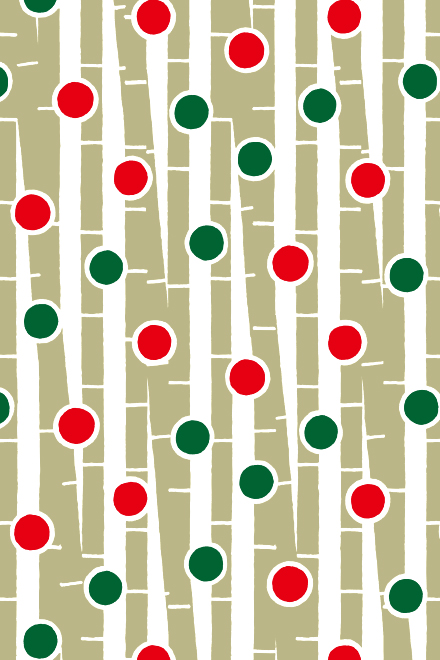
おめでたいお正月のお祝いに欠かせない松竹梅だが
何となく古めかしい感じもする。
思い切って抽象的にストライプと水玉で
松竹梅を表現し、言祝ぎたい。
(脇阪 克二)
"Celebration"(2009,by Katsuji Wakisaka)
Pine, bamboo and plum are the three most auspicious plants for the Japanese New Year,
However I find it a bit old-fashioned.
Therefore, I express them by some abstract stripes and dots to celebrate New Year.
| English translation by LIXIAOXIAO|
"Voeux"(2009, par Katsuji Wakisaka)
Le pin, le bamboo et le prunier sont les trois arbres synonymes de prospérité
pour le Nouvel An japonais mais je les trouve quelque peu démodé.
C’est pourquoi je souhaite célébrer le Nouvel An avec ces bandes et points,
représentant de façon abstraite ces trois entités.
| Traduction française par Jean-Baptiste Fauvel Matsumoto |
"言祝"(2009, 脇阪 克二)
松竹梅是新年必有的傳統意象,
但總覺得缺少新意。
我嘗試用抽象的線條和圓點來表現松竹梅,
恭祝新年吉祥。
| 中譯 : 李 瀟瀟 |
→こちらのテキスタイルデザイン商品
(Textile products with this pattern)
平成30年12月26日 水曜日号
“亥 平成30年”

猪突(ちょとつ)猛進するイノシシ
イノシシのように 自分の道を
まっしぐら進めるのは
素晴しいことですね
今年が そんな一年になりますように
(脇阪 克二)
"Year of the Boar"(2018,by Katsuji Wakisaka)
The boar rushes headlong without any worries or hasitations.
How wonderful it is, to go straight your own way just like the boar does.
I hope that we could all live like the boar this new year.
| English translation by Futaba Komori |
"Sanglier"(2018, par Katsuji Wakisaka)
Un sanglier qui fonce la tête baissée.
Suivre son propre chemin la tête la première,
tel un sanglier, est fantastique.
Que cette année en soit de même.
| Traduction française par Jean-Baptiste Fauvel Matsumoto |
"豬年"(2018, 胁阪 克二)
日本豬年的豬,指野豬。
寓意銳意進取,無所畏懼,勇往直前。
希望今年的你也有這般乘風破浪的勇敢。
| 中译 : 李 瀟瀟 |
→こちらのテキスタイルデザイン商品
(Textile products with this pattern)
平成30年12月25日 火曜日号
“祝い菱つなぎ 平成30年”
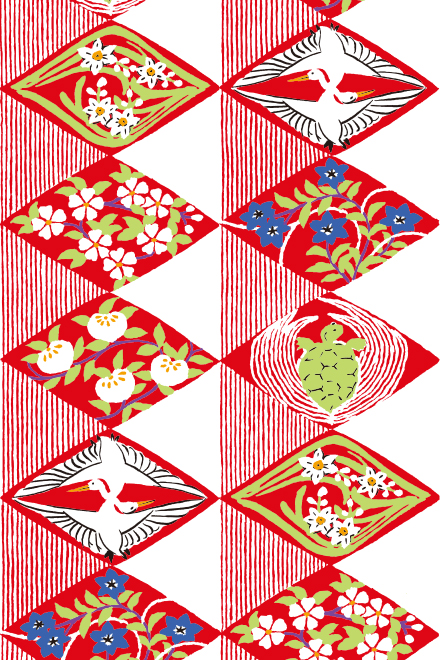

僕は長年 模様を描いてきたのですが
着物の世界には
実に多種多様な 模様があり
その表現の大胆さ、繊細さには
心奪われます。
日本人は着物をとおして
自分たちが大切にしている
季節感や喜怒哀楽を
精一杯表現していたのを感じます。
(脇阪 克二)
"Connected celebration-rhombus paettern"(2018,by Katsuji Wakisaka)
For long time I have been drawing patterns,
and have found out there are a great variety of patterns in the world of Kimono.
The boldness and delicacy of its style fascinates me.
I could feel that Japanese people were expressing
The seasones and emptions they value
through the patterns of Kimono.
| English translation by Futaba Komori |
"Motif en diamant"(2018, par Katsuji Wakisaka)
Je confectionne des motifs depuis de longues années
mais dans le monde des kimonos,
il en existe un nombre incalculable,
captivant de par leurs audaces et leurs délicatesses.
Les japonais prennent soin de leur personne
par le biais de leurs kimonos.
Pour moi, ils représentent à merveille les
saisons et les émotions.
| Traduction française par Jean-Baptiste Fauvel Matsumoto |
"菱形紋樣"(2018, 脇阪 克二)
我長年致力於創作織物紋樣。
在日本傳統和服世界,
存在著多種多樣的美好圖案。
表現手法大膽又細緻,令人傾心。
日本人通過和服,
淋漓盡致地展現日常中重視的季節感,
與喜怒哀樂的情緒變化。
| 中譯 : 李 瀟瀟 |
→こちらのテキスタイルデザイン商品
(Textile products with this pattern)
平成30年12月05日 水曜日号
“京の宿 平成22年”
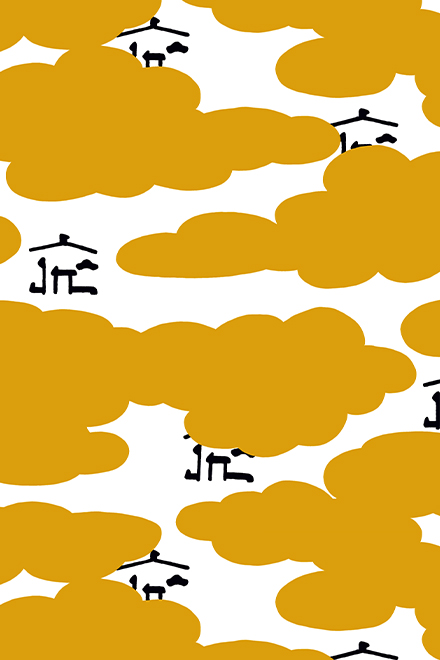
京都へは毎年五千万人の観光客が訪れる。
以前は静かな季節もあったが、今は訪れる人が絶えない。
「洛中洛外図」風に見ると雲の間に点々と宿が見える。
あの宿がいいかな、こっちの方がいいかな、
というのも旅の楽しさのひとつ。
自分に合った宿が見つかったとき、旅は一段と充実してくる。
(脇阪 克二)
"Stay in Kyoto"(2010,by Katsuji Wakisaka)
Kyoto gets arpound 50,000,000 visitors from all over the world each year.
There have been no longer off season and peak season throughout the year.
Take a birds-eye viw like Rakuchu Rakugai-zu portraying Rakuchu (the center of Kyoto) and Rakugai (a suburb) from above,
You can see those scattered hotels and guesthouses through clouds.
Hesitating where to stay in Kyoto and finally satisfied with the decision will undoubtedly lighten up your journey.
| English translation by LI XIAO XIAO |
"Auberge de Kyoto"(2010, par Katsuji Wakisaka)
Tous les ans, 50 millions de touristes se rendent à Kyoto.
Autrefois, il y avait des saisons creuses, ce qui n’est plus le cas aujourd’hui.
En observant Kyoto du ciel, on peut voir de nombreux logements à travers les nuages.
Un des plaisirs de voyager est également le choix d’une auberge qui nous corresponde.
Un logement répondant à ses attentes est synonyme de voyage réussi.
| Traduction française par Jean-Baptiste Fauvel Matsumoto |
"宿于京都"(2010, 胁阪 克二)
京都旅游曾經分淡季旺季,
現在每年有近5000萬人的游客造訪,
整年熙來攘往,絡繹不絕。
用「洛中洛外圖」的俯瞰視綫,
透過雲層,將遍佈在古城之宿盡收眼底,
住這間酒店好呢?還是訂那家民宿呢?
猶豫來猶豫去,煩惱的過程也是旅行的一部分。
最後找到自己心儀的酒店,讓旅程的充實感倍增,
也是許多人夢想宿于京都的魅力之所在吧。
| 中译 : 李 瀟瀟 |
平成30年12月01日 土曜日号
“みかん 平成30年”
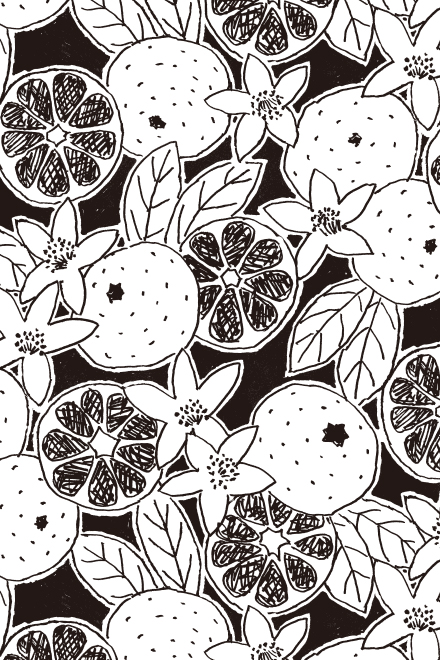
陽あたりのいい山の斜面
緑の中にオレンジ色の
丸い実が点々と見える
みかんは冬のものだが
温暖な地を好み成長する
太陽の光をいっぱい吸収した
みかんの皮をむきながら
食べていると 暖かい気持に
なってくる
(脇阪 克二)
"Orange"(2018,by Katsuji Wakisaka)
Orange trees bear fruits on that sunny slope.
Round and small, they popping out orange heads from the lush green trees.
Orange is a winter fruit but
It preferes temperate lands to grow.
Peel and eat a piece,
Piece by piece,
I bask in the warm sunlight that it has been fed throughout the growing season.
| English translation by LI XIAO XIAO |
"Mandarine"(2018, par Katsuji Wakisaka)
Sur le versant d’une montagne ensoleillé
on peut voir des petits fruits oranges dans la verdure.
La mandarine est un fruit hivernal mais
elle préfère les terres tempérées pour pousser.
Peler et manger une mandarine qui s’est nourrie
de la lumière du soleil est un tel plaisir.
| Traduction française par Jean-Baptiste Fauvel Matsumoto |
"蜜柑"(2018, 胁阪 克二)
向陽的山坡上,
綠色枝葉間隙,彈出三三兩兩的橙色圓腦袋。
蜜柑雖然成熟在冬天,
但卻偏偏生長在溫暖的地帶。
取一顆充分吸收了光與熱的蜜柑,
剝開柑皮,塞一瓣入口,
熱乎乎的陽光照心裏去。
| 中译 : 李 瀟瀟 |
→こちらのテキスタイルデザイン商品
(Textile products with this pattern)






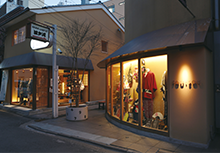
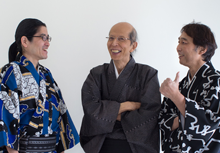

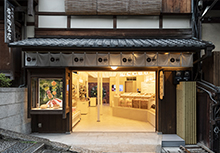

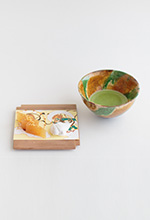
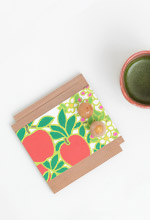
 お問い合わせ窓口
お問い合わせ窓口